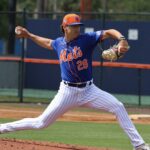
One of the bright spots from the 2018 season has been the emergence of Jeff McNeil. With his play in Binghamton and Las Vegas, McNeil forced his way onto the Major League roster even with the Mets seeming unwillingness to give him the promotion.
Through his first 44 major league games, McNeil is hitting .340/.401/.490 with eight doubles, four triples, two homers, and 14 RBI. Certainly, based on how the Mets were reluctant to call him up, it is fair to say the team never saw this coming. To be fair, no one really ever saw this coming. In fact, back in 2013, when McNeil was drafted by the Mets in the 12th round of the draft, Baseball America opined:
A left-handed hitter, he has a slashing approach and no power, but he could be an average hitter. He’s an above-average to plus runner, though his baserunning could use refinement. McNeil doesn’t have flashy actions in the infield, but he makes the routine plays and is versatile enough to play either middle infield spot or the outfield, helping him profile as a utilityman. His arm is fringy and fits best at second base.
To a certain extent, that draft profile proved true with only four home runs in his first three seasons. However, he did hit for a high average as, in 2013, McNeil hit .329/.413/.409 for Kingsport and in the ensuing season, he split time between Savannah and St. Lucie, hitting .292/.367/.394. McNeil continued his success at the higher levels in 2015 as well, hitting .308/.369/.377 between St. Lucie and Binghamton.
That 2015 performance did lead to him cracking Baseball America’s Top 30 Mets prospects entering the 2015 season. In naming McNeil the Mets 27th best prospect, Baseball America said, “Scouts regard McNeil as a strong fundamental player with plus makeup and instincts, but also one without a plus tool who profiles best as a utility player.”
Baseball America was far from the only outlet to hold that opinion. Entering the 2016 season, John Sickels of Minor League Ball said ranked McNeil as the Mets 17th best prospect noting he had a “Utility projection but not impossible he could exceed that.”
During the 2016 season, McNeil would suffer the first of what would be consecutive injury-plagued years. In 2016, he had a sports hernia which required season-ending surgery. In 2017, it was discovered McNeil had a torn labrum in his hip which required him to have surgery that would cut a second straight year short.
With him missing consecutive seasons, McNeil fell off of nearly everyone’s top prospect lists. Instead of looking at him as a potential utility player, he was not seen at all. That is typically what happens when you miss as much time as he did.
This year, with him finally being healthy, McNeil began to rake. He would actually out-hit top prospect, Peter Alonso, in Binghamton with a slash line of .327/.402/.626. This would lead everyone to re-visit McNeil and yet people still remained unimpressed.
For example, on July 6 of this year, Scott Delp of Baseball Prospectus said in a chat, in response to a question of where McNeil would fall on a prospective Ty Kelly – Daniel Murphy spectrum, Delp offered, “As a long-suffering Mets’ fan, I hate to say that McNeil seems a lot closer to the Kelly end of that spectrum.”
Now, the invocation of Murphy in the question was quite interesting. In fact, in an article by Andrew Battifarano of MiLB.com, Las Vegas manager Tony DeFrancesco likened McNeil to Murphy:
So far I’m really impressed with the way he’s progressed with the bat. Defensively, he’s been playing second base and he’s been showing some speed and quickness. … His swing does have some power to it to all fields. He kind of reminds me of Daniel Murphy, kind of that same type of moving around to second base, first base and the power came late.
Even with McNeil’s success impressing his manager, it still was not resonating with prospect analysts. In fact, while Keith Law of ESPN believed it was good news the Mets were calling up McNeil, he remained not sold on him. While citing McNeil being 26, Law proffered, “I don’t think he’s a prospect.”
In retrospect, Law’s statements do not hold up very well. Then again, none of the analysis on McNeil has held up. Looking over the scouting reports dating back to 2013, no one saw McNeil as becoming anything more than a utility player. Over the last three years, no one saw an increasingly injury-prone McNeil being any more than that.
This is not to say anyone was wrong. Rather, it is a testament to McNeil’s hard work and determination. Ultimately, where everyone saw a utility player or non-prospect, the Mets included, McNeil did all he could to become an everyday second baseman at the Major League level.














